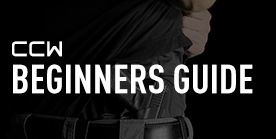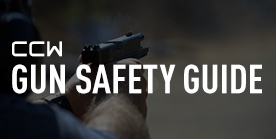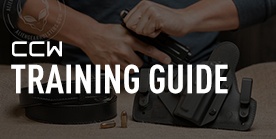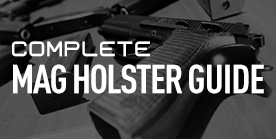A Quick Guide To Cleaning Your Gun: How Often You Should And Why You Need To

A Quick Guide To Cleaning Your Gun
Some people take pride in maintaining their guns, and some people take a perverse pleasure in not doing it. It is a chore to be sure, but like any chore…you have to do it at some point!
Granted, some guns barely need any cleaning…but some need more.
So let's go over why you want to keep your gun clean, how often, and how to go about it.
Why Do Guns Need To Be Cleaned?

Guns are basically a Rube Goldberg machine inside a metal (and/or metal and plastic) housing. If enough carbon and other stuff builds up on the right parts, it can affect operation.
The more you shoot, the more carbon, lead and copper builds up in the barrel, and the more carbon and lead builds up in the frame. The longer it goes between applications of lubrication, the more the lubricant breaks down and ceases to work...which can affect operation.
Now, a little bit is not a big deal. A little bit of carbon, a little bit of lead is no big whup, so it's not the case with most firearms that they have to be kept white-glove clean, but it's that it does have be done when it's needed.
Carbon fouling and copper in the barrel will eventually affect accuracy and will eventually start pitting the rifling. Carbon buildup on the slide and/or frame rails can inhibit travel, and yes even on a Glock.
So…not cleaning your gun can eventually lead to compromised function and reliability. How often do you need to? Well…that's a little more relative.
How Often Should You Clean Your Gun?

How often you should clean your gun depends on what kind of gun you have, how much you're shooting and how often. There isn't a set round count; it's more that if you're seeing a lot of carbon inside it, it's time to clean it.
If you don't shoot much and/or often - say a few boxes a year - cleaning is not much of an issue. However, if you shoot a high volume of ammunition (say a few hundred rounds in a sitting) and doing so regularly, that equation can change.
With that said, some guns - including various pistols, revolvers, rifles and shotguns - need to be kept cleaner than others or else you'll start having issues due to the design of that specific firearm. Just like cars, how to maintain them is the same - change fluids, rotate your tires, replace stuff when you have to - but exactly how you do those things depends on the make and model you drive.
Here's a really simple way to tell. If you field strip your gun, and it looks really dirty...you should probably clean it.
How Often You Should Clean Your Gun Depends On What Gun You Have

A modern polymer striker pistol like a Glock, an M&P, a Sig P320 doesn't need to be cleaned all that regularly. Clean the barrel once in a while, keep the frame rails lubricated and you're basically good.
When Glocks malfunction (they can and do, contrary to popular myth) one of the most common causes besides limpwristing is when the frame rails have too much carbon buildup and/or aren't lubricated.
There isn't much metal-on-metal contact, so there aren't many areas that are vital to keep clean. The only contact a Glock frame makes with the slide is four sheet metal tabs set in the frame; keep the frame rails and the tabs clean and lubricated, maybe add a few drops of lubricant to the top of the barrel and you're good.
The classic metal-framed pistols like 1911s, Hi Powers, all the old Wonder Nines (Beretta 92, Sig P226, CZ-75) and so on need - at minimum - the frame rails to be kept clean and lubricated at all times.
A good rule of thumb for those pistols is to clean the slide and frame rails after every shooting session, and apply lubricant. It's also a good idea to add a few drops of lubricant to the top of the barrel, basically anywhere there's metal-on-metal contact.
Carbon can eventually begin to act as an dry abrasive, wearing away material. 1911 pistols are especially susceptible; slide-to-frame fit can be worn away if you don't keep the slide rails clean and lubricated. The same applies to any of the above-mentioned legacy pistols with a lot of slide-to-frame contact.
A lot of people believe some absolute claptrap about revolvers, especially in regard to their maintenance. The most common revolver malfunction (besides timing issues) is carbon buildup under the ejector star, keeping the cylinder from locking into place or turning.
Don't take it from us; here's Chuck Haggard - career LE, firearms trainer and SME on OC spray - fondly reminiscing about the revolver era.
So revolvers have to be kept clean, especially the cylinders.
How Often Should You Clean A Rifle Or Shotgun?

The same idea basically applies with rifles and shotguns. If it looks dirty to you, clean it. There's no set round count, but it's a good idea to keep any area where there's metal-on-metal contact clean and lubricated.
Generally, you want to keep the bolt and the bolt recesses clean and lubricated for reliable lock-up. You don't have to keep them white glove clean, but just give them a good wipedown.
This approach - keep the barrel and bolt relatively clean and lubricated, do the rest as needed - works for all semi-auto rifles. AR, AK…it works for all of them.
It's a good idea to keep fouling out of the bore, as it can lead to rust. Shotguns should also be periodically cleaned to remove wad fouling. Bits of plastic get shaved off as the wad and shot column go down the barrel, which will decrease pattern density.
Top Tip: get a bore snake or ripcord and run it through the barrel after you're done shooting. It only takes a few seconds, and does basically everything you need to keep the barrel in good working order.
Pump-action and gas-operated shotguns need periodic cleaning and lubrication of the action bars, and it's a good idea to wipe down the receiver with an all-purpose gun cleaner/lubricant (CLP, RemOil, Ballistol, etc.) from time to time.
Of the semi-auto shotguns, inertia systems (Browning, Benelli, Stoeger) will tolerate neglect better than the gas guns.
However, it should be said that lever-action rifles - especially if you use black powder loads - are especially susceptible to fouling that can and will lead to less reliable cycling. They have to be cleaned and lubricated more regularly due to (you probably guessed it) a lot of metal parts that interact with each other.
So…with rifles and shotguns, the general rule is to keep the barrel and bolt clean and lubricated, and worry about the rest as needed.
How To Clean Your Gun

The first thing you want to do is have a secure, level space like a table or bench. It's also a good idea to have some sort of placemat to lay your gun on, like a gun mat. That way, you can keep your firearm and any components in one central location.
A good basic cleaning starts with clearing your gun of any ammunition. It's best to remove any ammunition from the area you're cleaning your gun in, as you don't want live ammo anywhere near the work bench so to speak.
For a basic cleaning, you'll want to field strip your gun.
The exact procedure depends on what kind of gun you have; field-stripping a Glock is different than field-stripping a 1911…and those are both different than field-stripping a revolver! However, all semi-autos strip "field strip" by taking the slide off the frame, and the barrel and spring out of the slide.
There is an exception for some blowback-operated pistols, such as a Walther PPK, HK P7, Makarov pistols, and Walther CCPs. These guns have fixed barrels, which are attached to the frame; field-stripping removes the slide and the recoil spring only.
Once your gun is field-stripped, a good basic cleaning is to wipe down the slide and clean off any carbon fouling. A simple all-in-one cleaner and lubricant is fine, and an old toothbrush is or Q-tip is perfect for it.

Wipe it down with a lint-free cloth and you're good to go.
The best tool for cleaning a barrel is a bore snake or an Otis Ripcord.
They're braided cords with a little bit of copper brush material at about the halfway mark of the cord. You put some borecleaner on the copper brush, a little bit of lubricant on the cord behind it, drop one end down the barrel and pull it through.
A couple of pulls with one gives you a good basic cleaning; "good enough for government work" as the saying goes. Some would argue that more than that isn't necessary, but some precision rifle shooters and bullseye pistol shooters have much lengthier and painstaking rituals to preserve accuracy.
Wipe down the outside of the barrel and the feed ramp with any all-purpose cleaner/lubricant. Make sure that any parts of the barrel that have metal-on-metal wear - you'll see the spots - are lubricated to reduce friction on those parts.
Wipe down any parts of the frame where metal contacts metal with your all-purpose cleaner/lubricant. Just make sure they have lubricant on them.
Then reassemble your gun. Wipe down the exterior of the slide with your all-purpose cleaner/lubricant, and dry fire to check function. That's it.
That's your basic cleaning. Anything beyond that requires full disassembly, and shouldn't be necessary for most people in most cases.
For long guns, you need to remove the bolt from the gun. A good wipe down with a cleaner/lubricant will typically suffice, though semi-automatic rifles (such as an AR, AK and so on) are best-served by removing the bolt from the carrier for a full wipedown and lubrication before reassembly.
Then use the appropriate bore snake/ripcord for that caliber. For a good basic cleaning of most rifles and shotguns, cleaning the barrel and wiping down/lubricating the bolt and carrier does a lot of good. In fact, it more or less does all the cleaning you need.
Shotguns and bolt action rifles can also benefit from taking the trigger group out and spritzing with an all-purpose cleaner/lubricant spray. Shake off the excess and reinstall.
And that's pretty much it. Clean your gun when it needs it, keep the bits that need it lubricated. Now get out and train.
Get Your FREE Gun Mat From Alien Gear Holsters!

But while you're here…you can get a FREE Alien Gear Holsters gun mat in our summer promotion.
Until the end of summer 2022, you can get a FREE gun mat of your choice or a free gun mat AND three Alien Gear Holsters-branded morale patches based on how much you spend.
Orders of $49 or more get a free gun mat with the design of your choice.
Orders of $99 or more get a free gun mat AND three morale patches to add to a range bag, vest, tactical jacket or patch wall.
If you wanted a gun mat, now is the time to get one as a bonus to go with qualifying purchases of Alien Gear Holsters products. Shop now, and get yours!










